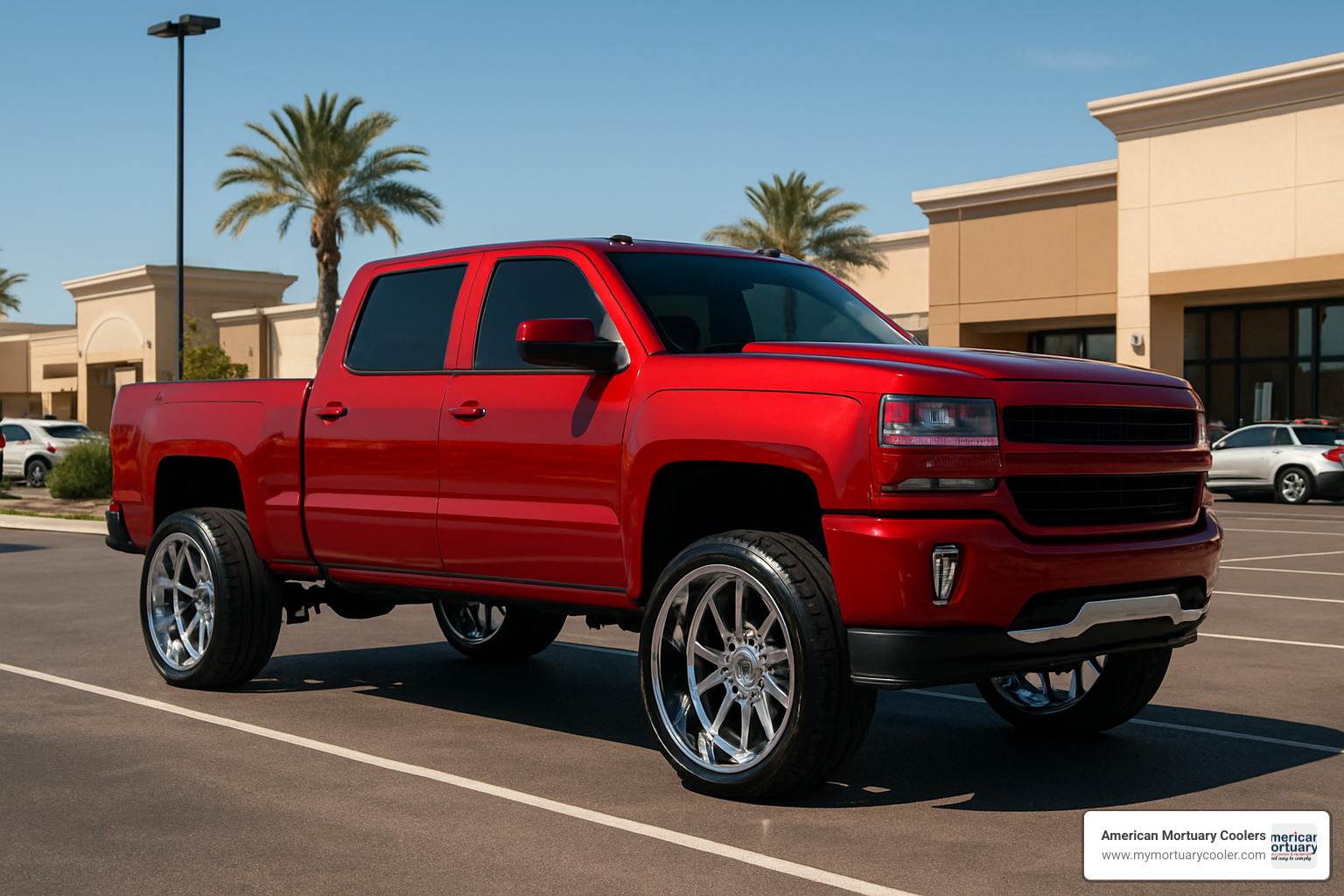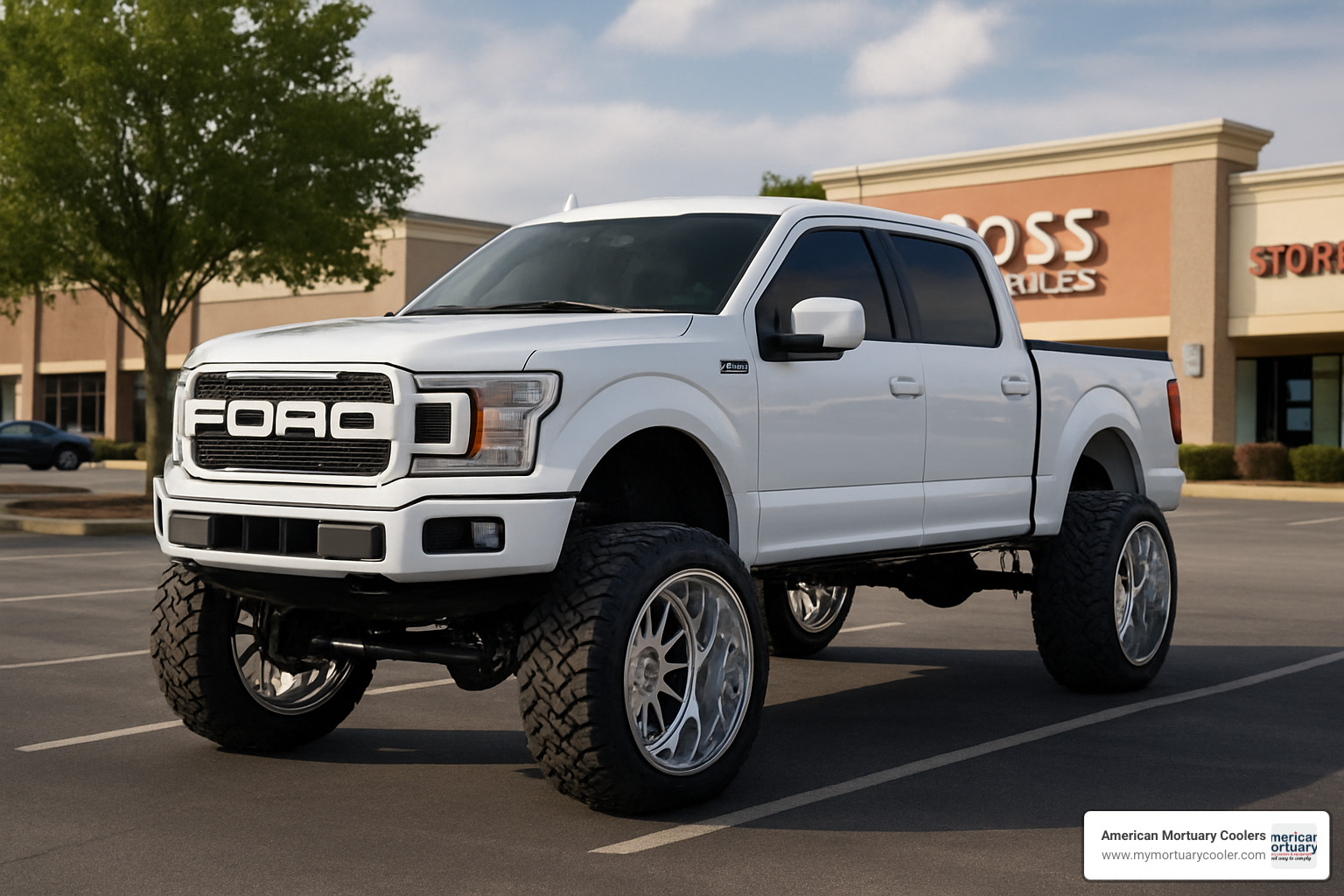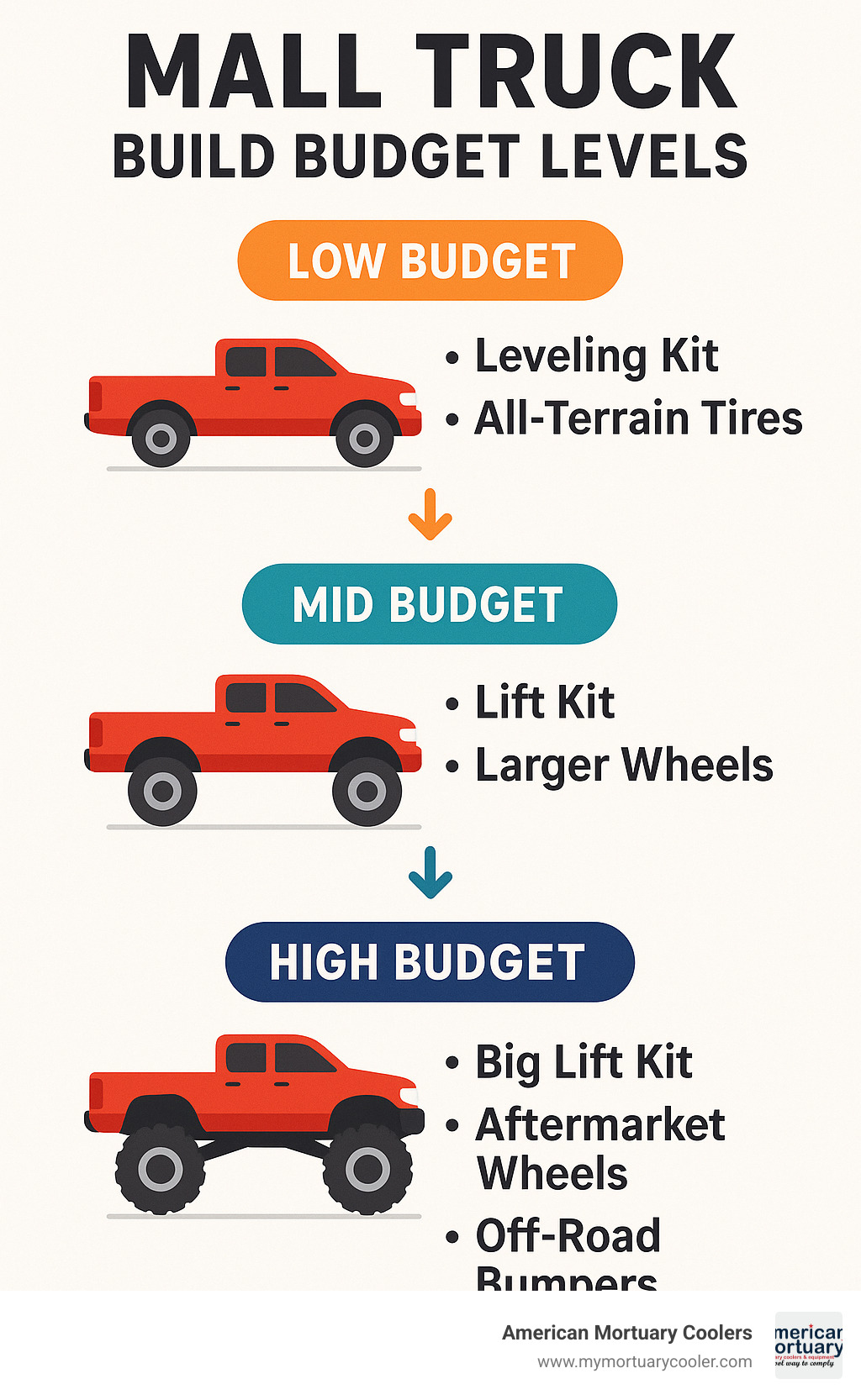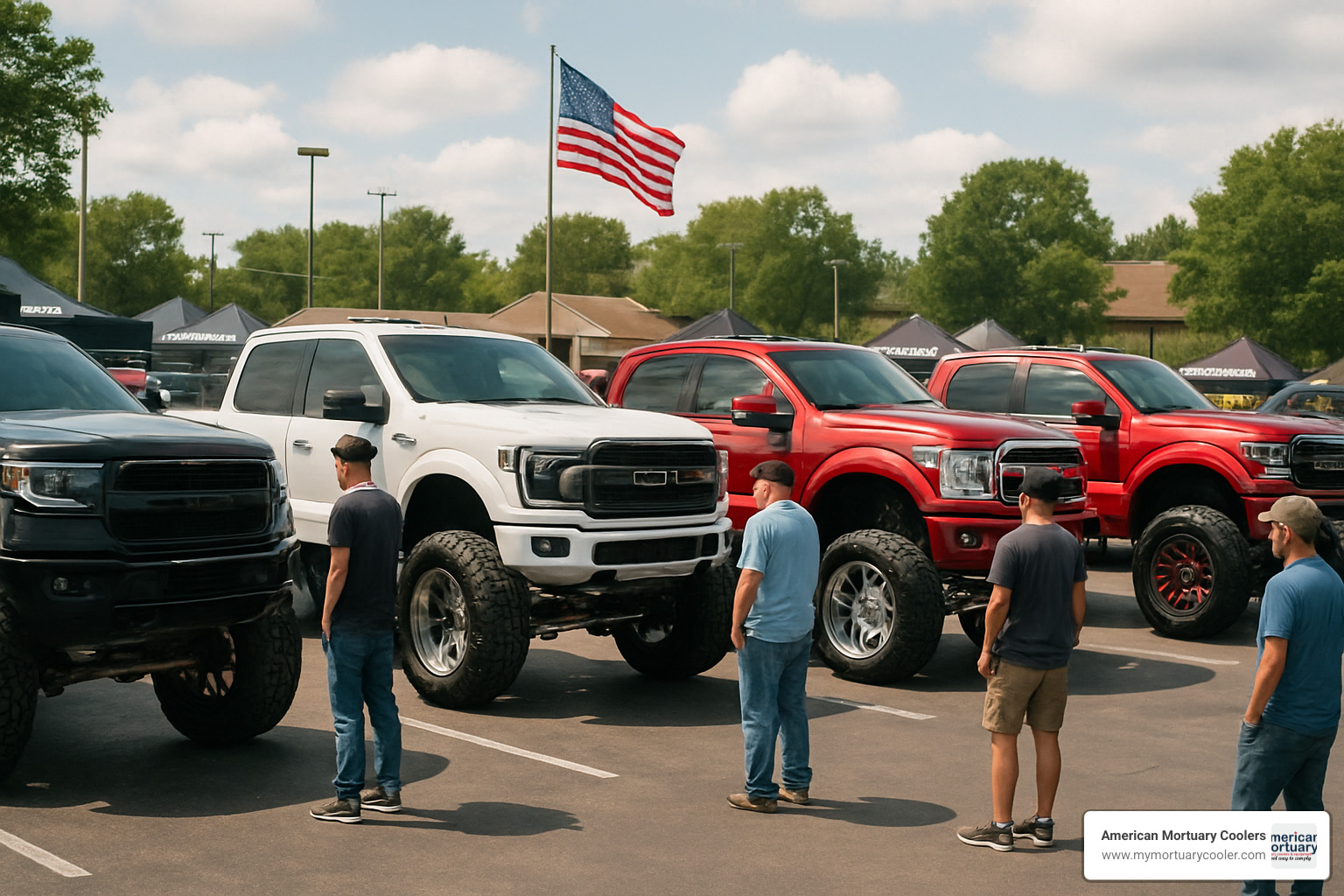Understanding the Mall Truck Phenomenon
A mall truck is a lifted pickup truck or SUV with aggressive off-road modifications that is primarily used on paved roads and rarely (if ever) taken off-road. These vehicles are characterized by their tall suspension lifts, oversized wheels, and rugged appearance despite being used mainly for everyday driving and mall parking lots.
What defines a mall truck:
- Significant suspension lift (4+ inches)
- Oversized wheels with low-profile tires
- Aftermarket off-road accessories (light bars, winches, etc.)
- Minimal actual off-road use
- Clean, unblemished appearance
Mall trucks represent the growing trend of vehicle customization focused on aesthetic appeal rather than functional necessity. While they feature modifications designed for rough terrain, these vehicles spend most of their time on city streets and shopping center parking lots—hence the somewhat derogatory nickname "mall crawler."
The phenomenon has roots in the 1990s lift-kit boom but has exploded in popularity with the rise of social media and the expansion of the aftermarket parts industry. Today, a mall truck serves as both a status symbol and a creative outlet for owners who appreciate the rugged look without necessarily needing the off-road capability.
Unlike purpose-built off-road vehicles that show signs of trail use, mall trucks typically maintain a pristine appearance with spotless undercarriages and scratch-free exteriors. The trend reflects broader automotive customization culture where appearance modifications often outweigh practical considerations.
I'm Mortuary Cooler, and while my expertise lies primarily in mortuary transportation solutions, I've observed how mall truck customization parallels the specialized vehicle modifications we see in commercial and funeral transport—right down to mall trucks occasionally being repurposed as mobile display or promotional vehicles.

Related articles from our wider blog network that explore other specialty equipment and customization topics:
What Is a Mall Truck? Origins & Evolution
The journey of the mall truck is a fascinating evolution from rugged utility to stylish statement piece. These eye-catching vehicles represent the intersection of automotive innovation, cultural shifts, and our desire to stand out from the crowd.
Looking back, we can trace some roots to 1897 when Rudolf Diesel developed the first prototype of his engine. This invention would eventually power countless heavy-duty trucks built for serious work. What would Rudolf think if he could see his engineering marvel now powering gleaming chrome-laden vehicles that rarely venture beyond city limits!
As the 20th century progressed, trucks underwent a remarkable change from purely functional work vehicles to family-friendly daily drivers. Manufacturers added comfort features and style options, setting the stage for the mall truck phenomenon.
The Mall Truck Defined
A mall truck embodies a fascinating contradiction – it's a vehicle modified to look like it could conquer Mount Everest but primarily used for cruising to Starbucks and navigating parking garages.
What makes a truck a "mall truck"? It's not just looks, but lifestyle. The typical mall truck sports a substantial suspension lift (usually 4-8 inches), oversized wheels (20+ inches) with low-profile tires that would struggle on actual trails, and aftermarket bumpers often equipped with pristine winches that have never tasted mud. Many feature light bars that rarely illuminate anything more adventurous than a drive-thru menu, plus immaculate undercarriages showing zero evidence of off-road trips.
The most telling characteristic is the truck's natural habitat – not rocky trails or muddy backroads, but smooth asphalt and shopping center parking lots. It's this disconnect between capability and actual use that earned these vehicles their nickname.
A Brief History of the Mall Truck Craze
The mall truck trend gained serious momentum in the 1990s, coinciding with a perfect storm of automotive and cultural developments. This decade saw the lift-kit industry boom as aftermarket suspension companies expanded their offerings, making modifications more accessible to average consumers.
Meanwhile, truck-based SUVs like the Ford Expedition and Chevy Tahoe grew in popularity, creating a market for lifted family vehicles that combined practicality with an adventurous appearance.
The explosion of social media in the 2000s and 2010s accelerated this trend. Platforms like Instagram and YouTube created spaces where owners could showcase their builds, inspiring others and creating community around these striking vehicles.
Truck manufacturers weren't blind to this trend, either. Seeing the growing demand, they began offering factory lift options and off-road appearance packages straight from the dealership.
By the mid-2010s, the mall truck had cemented itself as a recognizable cultural phenomenon with dedicated online communities, specialized parts suppliers, and even reality TV shows featuring extreme builds.
Mall Truck vs. Other Truck Genres: Features, Mods & Performance
Ever wondered what sets a mall truck apart from other custom pickups? While they might share similarities in appearance, the intent behind these builds couldn't be more different.
Think of truck customization as existing on a spectrum. On one end, you have purpose-built off-road rigs with battle scars and mud-caked undercarriages. On the other, you have pristine mall trucks with gleaming chrome that's never seen anything rougher than a speed bump.
| Feature | Mall Truck | Brodozer | Trail Rig |
|---|---|---|---|
| Primary Use | Paved roads, parking lots | Highway driving, showing off | Actual off-road trails |
| Suspension | 4-8" lift, often for looks | 8"+ lift, often excessive | 2-6" lift, functional |
| Wheels | 20"+ chrome/painted alloys | 22"+ with thin tires | 16-18" with thick sidewalls |
| Tires | Low profile, minimal tread | Aggressive tread, rarely used | Mud/all-terrain, well-used |
| Lighting | Multiple LED bars (rarely used) | Excessive LEDs, light bars | Strategic placement for actual use |
| Appearance | Clean, polished, unblemished | Extreme, often with "coal rolling" | Scratched, muddy, used |
The heart of the difference isn't in the parts themselves, but in how they're used. A trail rig's scratches tell stories of trips, while a mall truck's spotless paint tells a different tale altogether.

Signature Mall Truck Modifications
Walk through any upscale shopping center parking lot on a weekend, and you'll notice patterns in these pavement princesses. Mall trucks typically sport eye-catching upgrades that emphasize style over substance.
Those chrome wheels are hard to miss – often 20 inches or larger, with tires so thin they'd puncture on a serious trail. The suspension lift gives the truck an imposing stance, though it's rarely used for clearing obstacles more challenging than a curb.
Many mall trucks feature snorkels mounted high on the A-pillar – a modification designed for deep water crossings that these trucks will likely never attempt. The same goes for those blinding LED light bars that could illuminate a forest trail but instead mostly impress other drivers on the highway.
The bed covers are another telltale sign – often color-matched and pristine, protecting a cargo area that rarely carries anything dirtier than groceries. Add tinted windows, custom grilles and bumpers, and heritage two-tone paint schemes that recall classic truck designs while maintaining a modern edge.
How Mall Trucks Perform on and off Pavement
Here's where the mall truck paradox becomes apparent – these modifications often make the vehicle worse at everything except looking cool in a parking lot.
On the highway, that towering suspension creates a higher center of gravity, making the truck less stable in corners and increasing rollover risk. Those heavy, oversized wheels extend braking distances and strain steering components. And that aggressive stance creates enough wind resistance to reduce fuel economy by 3-5 mpg or more.
The mall truck's ride comfort often suffers too. While stock trucks are engineered for balance, lift kits focused on appearance often result in a harsher ride. Add road noise from aggressive tires and modified exhaust systems, and long drives become less pleasant.
The real irony emerges when these trucks occasionally venture off-road. Despite looking ready to tackle tough trails, most mall trucks would be quickly outperformed by stock 4×4s with appropriate tires. Those low-profile tires provide minimal grip in mud or sand, and many aesthetic-focused lift kits actually reduce wheel articulation compared to purpose-built off-road systems.
Popular Models, Builds & Budget Breakdown
Let's talk about what makes the perfect mall truck. Some vehicles just seem destined for this lifestyle, offering the right mix of size, style, and modification potential.
The Ford F-150 reigns supreme in the mall truck world. America's best-selling truck provides an excellent canvas with its aluminum body (which helps offset some added weight from modifications). Whether you start with a basic XL or splurge on a Limited or Raptor, the F-150 gives you plenty of options.
Right behind Ford, the Chevrolet Silverado and GMC Sierra attract plenty of mall truck enthusiasts. These GM twins offer bold, aggressive styling that looks menacing even before modifications. Their front ends practically scream "look at me!" as you cruise through town.
The Ram 1500 has carved out its own niche in the mall truck scene. Its comfortable coil-spring rear suspension makes it a smoother daily driver, while that distinctive styling sets it apart from the Ford and Chevy crowd.
For those wanting something different, the Toyota Tundra offers Japanese reliability with American-sized presence. While less common than domestic options, a modified Tundra definitely stands out in a parking lot.
Budget-conscious builders might consider the Ford Maverick, which starts at a more accessible $28,145 for 2025 models. Its smaller size limits some modification options, but it's opening up the mall truck lifestyle to folks who can't afford a full-size truck.

Iconic Mall Truck Builds to Inspire You
Within the mall truck community, certain builds have achieved almost legendary status. The Heritage Edition F-150s with their beautiful two-tone paint schemes have become particularly coveted. These special editions blend nostalgic styling from early-2000s F-150s with modern tech.
The Black and Chrome Silverado builds have become a mall truck staple. There's something about that striking contrast between blacked-out trim and gleaming chrome wheels that turns heads wherever they go.
For Ram enthusiasts, the color-matched everything approach has become popular. Starting with a Ram Sport and extending that body color to the bumpers, grilles, and wheel lips creates a cohesive, premium look.
Regional influences have created distinct styles too. The "Texas Edition" builds feature extra chrome, special badging, and often dual exhaust systems that make a statement as big as the Lone Star State itself. Meanwhile, in warmer climates, the "Platinum White" aesthetic dominates – pristine white trucks with color-matched bumpers, either chrome or black wheels, and tinted windows.
What It Really Costs to Build or Buy a Mall Truck
Let's be honest about the investment required for a proper mall truck. This isn't a budget-friendly hobby.
For your starting platform, expect to pay between $45,000-$70,000 for a new full-size truck. Going the used route (typically 3-5 years old) might save you some cash at $30,000-$45,000, but you're still looking at a significant initial investment.
The essential modifications add up quickly. A quality suspension lift kit (4-6") will set you back $1,500-$4,000, plus another $1,000-$2,500 for professional installation. Those eye-catching wheels? Plan on $2,000-$5,000 for a set of four, with tires adding another $1,200-$2,500.
When you add it all up, a budget build based on a used truck with moderate modifications will typically run $40,000-$60,000. A mid-range build with a new truck and quality modifications pushes that to $65,000-$85,000. And those premium builds with high-end trucks and extensive customization? You're looking at $85,000-$120,000+.

Culture, Criticisms & Choosing Your Own Mall Truck
Let's face it – the mall truck world isn't just about big tires and shiny chrome. It's about belonging to something, expressing yourself, and sometimes dealing with a few raised eyebrows along the way.
Why People Love the Mall Truck Lifestyle
For many enthusiasts, a mall truck represents freedom and self-expression in a way few other possessions can. Your truck becomes a rolling canvas that tells the world who you are without saying a word. The perfect combination of wheels, paint, and accessories creates something uniquely yours that stands out in a sea of factory-standard vehicles.
There's something genuinely satisfying about seeing your vision come to life, piece by piece. Many owners describe the building process as therapeutic – a creative outlet that delivers tangible results you can enjoy every day.
Beyond personal satisfaction, mall trucks create instant community connections. Pull into any cars and coffee event with your customized rig, and you'll likely find yourself in conversation with fellow truck enthusiasts comparing notes on builds and sharing tips.
For some owners, there's no denying the status symbol aspect. A well-executed mall truck signals both automotive enthusiasm and financial success. That gleaming truck in the parking lot tells others you care enough about your vehicle to invest significantly in making it stand out.

Common Criticisms of the Mall Truck Scene
Of course, not everyone appreciates the mall truck phenomenon. Critics often point to several legitimate concerns worth considering.
The environmental impact can't be ignored – those larger tires, higher profiles, and often more powerful engines significantly reduce fuel efficiency. Many mall truck owners report 3-5 MPG drops after modifications.
There's also the practical irony that many modifications actually reduce utility. That beautiful truck might look ready to conquer mountains, but the lowered payload capacity, compromised handling, and reduced towing capability might make it less capable than a stock model for actual work.
Safety concerns arise too. The higher center of gravity increases rollover risk, while those impressive LED light bars can temporarily blind oncoming drivers when used on public roads. And let's talk about parking – those wide stances often mean taking up more than one space or making tight parking garages a nightmare.
Perhaps the most common criticism comes from the off-road community itself, who often view mall trucks as "all show, no go" – having the appearance of capability without the actual function or experience.
How to Select the Best Mall Truck for Your Needs
If you're still excited about joining the mall truck community despite the criticisms, here's how to make choices you'll be happy with long-term:
Start with honesty about how you'll actually use the truck. There's nothing wrong with building primarily for looks if that's what brings you joy – just be realistic about your needs.
Budget realistically by looking beyond just purchase and modification costs. Factor in ongoing expenses like increased fuel consumption, higher insurance premiums, and more frequent maintenance.
Research warranty implications thoroughly. Many modifications will void parts of your vehicle's warranty, so understand these tradeoffs before proceeding.
When planning your build, quality over quantity almost always yields better results. One set of premium wheels makes a stronger statement than a collection of cheap modifications that may fail or look tacky.
Consider resale value in your planning. While some modifications can actually increase value in the right buyer's market, others dramatically shrink your potential buyer pool.
Creating a modification roadmap allows you to build in stages rather than all at once. This approach spreads costs over time and lets you adjust your vision as you go.
Frequently Asked Questions about Mall Trucks
What makes a "mall truck" different from a true off-road rig?
Mall trucks are built primarily for show—they're the peacocks of the truck world. They sport eye-catching modifications that look impressive in parking lots but might actually make off-roading more difficult. Think massive chrome wheels wrapped in thin, low-profile tires that would puncture on the first rock they meet. Their owners typically keep them spotlessly clean, with nary a scratch or speck of mud to be found.
True off-road rigs, on the other hand, wear their trips like badges of honor. You'll spot them by the authentic trail marks—mud splattered undercarriages, "pinstriping" from brush encounters, and rock rash on their skid plates. Their modifications serve practical purposes: chunky all-terrain tires with thick, protective sidewalls, functional skid plates, and recovery gear that shows signs of actual use.
Perhaps the most telling sign? Check underneath. A mall truck's undercarriage gleams like new, while a trail rig's tells stories of trips through dirt, rocks, and mud.
Do mall trucks provide any real functional benefits?
Despite the criticism mall trucks often receive for prioritizing looks over function, they do offer some genuine advantages in everyday driving situations.
That lifted position gives you a commanding view of the road ahead, making it easier to spot potential hazards in traffic. This height advantage really shines in regions with severe weather—powering through deep snow becomes less daunting, and those occasional flooded streets that would stall a sedan are much less threatening.
Some owners also appreciate the perceived safety benefits. In certain collision scenarios, sitting higher with more substantial vehicle structure around you can provide additional protection (though the higher rollover risk is the trade-off).
There's also something to be said for the confidence boost many owners report. There's a psychological benefit to feeling capable and prepared, even if you never actually test those capabilities off-road.
How much should I budget to build a respectable mall truck?
Building a mall truck that turns heads without emptying your bank account requires careful planning. The investment varies widely depending on your vision and the quality of components you choose.
For an entry-level build that earns respect without breaking the bank, budget around $10,000-$15,000 in modifications beyond your base truck. This gets you a quality 4-inch suspension lift, decent wheels and tires, basic appearance upgrades like a custom grille and bumpers, some lighting improvements, and simpler exhaust modifications.
Moving up to a mid-range build ($15,000-$25,000 in modifications) opens more doors. Now you're looking at a premium 6-inch lift kit, high-end wheels wrapped in impressive rubber, comprehensive exterior upgrades, an attention-grabbing lighting system, performance exhaust and intake improvements, and interior upgrades.
For those with deeper pockets seeking the ultimate statement vehicle, premium builds start around $25,000 and can easily exceed $50,000 in modifications alone. At this level, you're investing in custom suspension systems, forged wheels, custom bodywork and paint, integrated lighting systems, significant engine performance modifications, and luxury interior upgrades.
These figures don't include your starting truck, which might range from $30,000 for a solid used model to $70,000+ for a new premium truck. And don't forget the ongoing costs—expect your fuel economy to drop by 3-5 mpg, plan for more frequent tire replacements, and prepare for potentially higher insurance premiums.
Conclusion & Next Steps
The mall truck phenomenon captures something special about American car culture—it's where engineering meets self-expression in the most eye-catching way. These towering tributes to automotive excess aren't just vehicles; they're rolling statements about their owners' personalities, aspirations, and priorities.
Love them or roll your eyes at them, mall trucks have carved out their own cultural territory in parking lots across America. They speak to our desire to customize, personalize, and make statements with our possessions, even when those statements might seem contradictory to practical considerations.
If you're feeling the pull toward building your own gleaming, lifted showpiece, approach the journey with both enthusiasm and wisdom. Research thoroughly before making modifications—what looks good on Instagram might not feel so great on your daily commute. Budget realistically, remembering that the initial build is just the beginning of your financial commitment. Try to find balance between turning heads and still being able to use your truck for actual truck things.
Most importantly, enjoy the process. Building a mall truck should be a creative journey, not just a race to check modification boxes. The truck community is diverse, with room for everything from mud-covered trail rigs to pristine pavement princesses—respect diverse perspectives and you'll find the experience much more rewarding.
At American Mortuary Coolers, we understand specialized vehicles from a different angle. While we focus on function over form in our mortuary transport solutions, we share that appreciation for customization that truly serves its owner's needs. Based in Tennessee, we deliver our custom mortuary coolers and equipment across all 48 contiguous states, bringing the same attention to detail that truck enthusiasts pour into their builds.
The mall truck trend continues evolving, with each season bringing new styles and approaches. What stays constant is the passion behind these builds—the vision of owners who see their trucks as extensions of themselves and expressions of their identities.
Whether you're planning a towering chrome-laden cruiser for weekend mall runs or seeking specialized transport solutions for professional needs, the key is making choices that align with your real-world requirements while still bringing you joy.


















